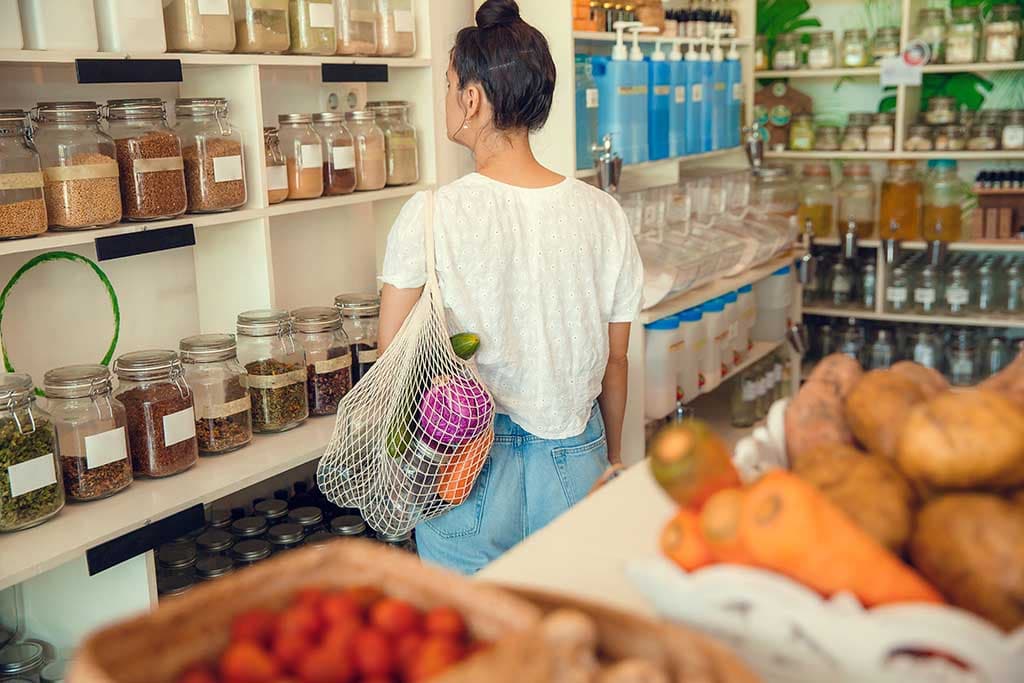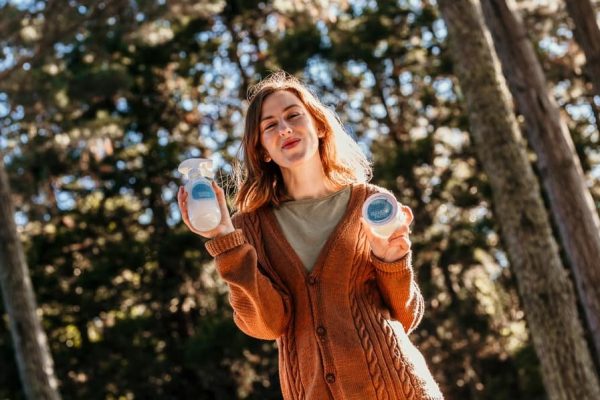If you’re just starting out on your sustainability journey, the first few steps can feel overwhelming – they were for me!
The best advice I can anyone new to learning how to reduce their impact and live a little more sustainably is this.
Don’t let it overwhelm you. Start with one thing and grow from there. The most important thing to know is that it’s about the mindset shift that comes from the individual actions we take.

You don’t become an eco-activist overnight
It starts small with our individual actions like composting and using reusables.
With these small changes you start to become more aware of the issues like plastic pollution and Climate Change and fast fashion, you begin to understand the importance of collective action and system change. And that’s when your actions can inspire and influence the people around you to make changes as well.
You may already be doing a few of these things, which is fantastic! Remember do what you can with the tools you have available to you.
We can’t do everything but we can all do something
34 sustainable living tips
1. Eat less meat. This is the single most impactful lifestyle change you can make to help the planet. Industrialised agriculture is responsible for 15% of global carbon emissions, and contributes to water pollution and land use. Commit to reducing your meat consumption by a few meals per week. Start with meat-free Mondays, and gradually move to eat meat only once or twice a week. Learn more about the Climatarian diet here.
2. Recycle. Something we’re taught from a fairly young age that has a significant impact on reducing waste going to landfill. Unfortunately, not all councils have the same recycling rules so check out this guide to help get you started.
3. Reduce food waste. Roughly one-third of all food produced for human consumption around the world goes to waste. Environmentally, it accounts for about 8% of all global greenhouse gas emissions, 24% of the freshwater and 28 million tonnes of the fertilisers and pesticides used in agriculture. If food waste was a country, it would be the third biggest emitter of greenhouse gases after the USA and China! Some tips to help you waste less food. Meal plan, write a shopping list and stick to it. Freeze leftovers or food about to go off. Get creative with meals and use leftovers. Share meals with neighbours.
4. Invest wisely. Sadly your superannuation and your bank are probably funding fossil fuel ventures. Australians have around 2 Trillion dollars in Super, and about 50% is thought to be supporting polluting companies. Look for a super fund that does not in any way support the fossil fuel industry. Our guide to ethical investing here.
5. Buy a water saver. Back on the topic of saving water. One of the most simple ways to do that is to install water-saving devices on your sinks and showers. These devices can save up to 50 liters of water per person per day.
6. Reduce plastic. Nearly half of all ocean pollution comes from activities that take place on land. Plastic pollution is an environmental catastrophe and we need to do something about it now. Everything you need to know about reducing plastic or going zero waste here.
7. Buy me once. Going back to the days of our great grandparents when they brought something, it was for life. Sustainability means investing in well-made products, clothes, appliances, furniture, things that won’t break beyond repair and end up in landfill.
8. Compost. Your food scraps may seem harmless but when food accumulates in landfills, it begins to decompose, it’s then broken down by bacteria through anaerobic digestion which means there’s not enough oxygen reaching all the food waste. Without oxygen to facilitate the decaying process the food waste begins to produce methane a greenhouse gas that is 21 times more potent than carbon dioxide. The simple act of composting can have an enormous positive impact on the health of our planet and it’s so easy to do.
9. Watch an environmental documentary to help get you fired up. Here’s a list to get you started.
10. DIY. Not an option for everyone, but if you have the time and inclination, making your own food (bread, nut milk, snacks, etc) and cleaning products using ingredients from plastic-free stores like The Source can save on packaging, materials, and transport. Making it a greener option than buying from the supermarket.
11. Look for green energy. Say goodbye to coal and switch to a green energy provider. More info here.
12. Sign petitions. Yes, they do have an impact! The key is to sign the ones who have the power to add political pressure from major organisations such as Greenpeace or the Australian Conservation Foundation.
13. Grow your own. Buying locally grown food from the farmer’s market is a great way to minimise your environmental impact, but growing your own food takes it to the next level. Not sure where to start? Slow Down and Grow Something is a great book for beginners. I personally use the Salad Table. A combination of water and nutrients feed the food, no soil and it’s pretty much set and forget. They have multiple sizes perfect for backyards, smaller spaces, and apartments.
14. Wash in cold. Roughly 75% of the energy required to do a load of laundry goes into heating the water. Set your machine to 20 degrees or less to reduce power usage and make your clothes last longer.
15. Plant a tree. Planting trees offset the emissions we produce. The Carbon Neutral Charitable Fund is working to restore landscapes and revive biodiversity in Australia with its tree-planting projects.
16. Rent. Why buy when you can rent? From dress hire to cars and camera gear. So much of what we need can be rented these days. This shift in borrowing what we need only when we need it could be the end of ownership. Sites like FatLlama help you rent out your stuff and borrow what you need.
17. Buy local. Food grown and purchased locally has less distance to travel, which means fewer emissions, reducing your carbon footprint and supporting and you’re supporting your local farmers. If you don’t live near a farmer’s market, try searching for online stores that grow and deliver produce in your region.
18. Walk, ride your bike, care share, or take public transport. Transport – cars, trucks, public transport, domestic flights, and shipping – is Australia’s second largest source of greenhouse gas pollution. If you can avoid driving, opt for greener transport where you can.
19. Repair. There’s one key way to combat buying more stuff, learn how to fix or update the old. You don’t necessarily need to whip up a handbag from an old pair of jeans, but it’s a fun way of creating ‘new’ stuff that’s unique. Even just learning how to sew on a button is the first step to fighting the consumer loophole of buying new stuff. Heres how.
20. Buy preloved. For the same reasons above, embracing op-shopping and buying preloved fashion is great for the environment. The environmental benefits range from fewer carbon emissions to saving water and reducing waste. Second-hand is not second best and you pick some fantastic bargains in thrift stores. Here are some tips to op shop like a pro.
21. Be water wise. With much of rural Australia (and the world) experiencing severe droughts, we need to consider out water use. Simple habits like turning off the tap while you brush your teeth and the shower while you soap up can save thousands of liters a year. Have shorter showers. Fix leaks, even it’s a minor drip. Keep a bucket in your shower to collect runoff water to use on your indoor plants. Water your garden less, or create a garden using drought-resistant plants.
22. Embrace slow fashion. Buy less, choose well, make it last. Vivienne Westwood’s oft-quoted words of wisdom encourage us to slow down in this era of fast fashion. According to the Ellen Macarthur Foundation, global clothing production has doubled in the past 15 years, with garments on average being worn much less and discarded quicker than ever before. Fashion is one of the most natural and polluting industries in the world. Producing 20% of wastewater while also generating more greenhouse gas emissions than all international flights and maritime shipping combined. We need to slow down and invest in clothes we will love and wear for many years.
23. Share your car or borrow. For the same reasons as above consider ride-sharing instead of ownership. With sites like GoGet and Car Next Door, sharing just got easier.
24. Ditch dairy. It’s estimated that there are 270 million dairy cows worldwide. Dairy production has a considerable effect on climate change due to emissions of greenhouse gases such as methane, nitrous oxide, and carbon dioxide. With a growing global population and increased demand for dairy, there’s also growing pressure on natural resources such as freshwater and soil. Id going dairy free is not an option, try limiting to a few times a week.
25. Air dry. Ditch the dryer aka the power sucker and hang your clothes on the line. You’ll save energy, benefit from less creased clothes and, the antibacterial properties of the sun. UV kills bacteria so hanging clothes on the line goes hand in hand with cold washing.
26. Wash less. We don’t actually need to wash our clothes after every wear. Unless they smell or have visible stains, your outfit is fine to hang back in the wardobe for another wear. For odours and stains, spot clean or spray the areas that need cleaning. Then hang them outside in the fresh air and sunlight to dry.
27. Get educated. We literally have the entirety of the universe’s information in the palm of our hands. Spend a little time reading up on climate change and its impacts. Knowledge is power.
28. Donate. NGO’s such as the abovementioned rely on donations to help keep them in operation. Even small donations of $2 can help.
29. Drive an electric car. Need a new car? Why not make it an electric one. EV’s are on the rise and becoming more affordable every year. More on electric cars here.
30. Create change in your workplace. Resources, energy use, waste, indoor air quality, are all areas that can be improved upon for a sustainable workplace. If you see areas that can be improved, speak to your boss about evaluating and addressing your workplaces environmental impact.
SUSTAINABLE LIVING
These are just a few tips from my course “How to Live Sustainably in a Way That Fits Your Lifestyle”.
There’s so much confusion around living more sustainably. I want to make it really simple for you by sharing easy to implement, practical tips to help you make sustainable swaps in your everyday life.
Inside the course you’ll find 6 self-paced modules covering:
- What is Sustainable Living?
- Being a Conscious Consumer
- Rubbish & Recycling Guides
- Reducing Plastic & Reusables
- Food Waste & Plant-Based Eating
- Tackling Climate Change as Individuals
The videos are between 5-10 minutes each – I have purposely kept them short and easy to watch. And you can watch them on your computer, tablet, or phone.
Each video is accompanied by a download jam-packed with information including:
- 110 pages of resources for you to download and keep
- Tasks to help you start and keep making sustainable swaps in your life
- Links to further learnings, books, films, and campaigns to be part of
- Recommendations to my favourite tried and tested products, stores, and some discounts codes for you
This course is for anyone who wants to learn how to have an impact through your own small daily actions – all it takes is a few simple swaps and forming some new habits. You can find it here.
31. Have a conversation. Talk to friends, family, your neighbours, postie, anyone who will listen! One of the most powerful things you can do to take action on climate change is to talk about it. Most of the time it’s just a lack of awareness or understanding of the issues that drive string anti-climate opinions. Listen to their concerns, invite them to ask questions and be ready with answers. Remember to keep your cool, it’s easy to get frustrated when someone doesn’t agree with you.
32. Get political. Smaller independent political parties like the Australian Greens don’t take corporate donations, instead, they ask for people to get involved within their local communities. Read more about how you can get involved here.
33. Educate your children. They are the future and the ones who have to live in the world after we’re gone. Arm them with the knowledge that they have the power to make the world a better place. Support and encourage them to learn and innovate and come up with the solutions they need for a cleaner, better future.
34. Start a movement. The Women’s Marches, School Strike 4 Climate, Extinction Rebellion, all started from an individual or small group of people who wanted to make a difference. You have that power too.


